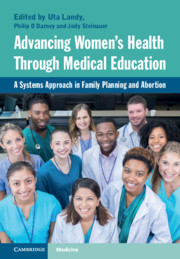 Advancing Women's Health Through Medical Education
Advancing Women's Health Through Medical Education from Section I - Abortion Training: Workforce, Leadership, Social & Political Impact
Published online by Cambridge University Press: 30 July 2021
Physician approval or condemnation, advocacy or opposition, to abortion have often determined whether women can avoid the complications of unsafe abortion and, sometimes, early death.In the USA organized medicine’s early opposition to abortion outlawed it.A century later, obstetricians recognized the importance of abortion to public health.They fought to end restrictions, eventually making abortion legal in several states. At first, individual physicians violated restrictive laws, risking jail and their medical licenses.Colleagues soon supported this “civil disobedience” and influenced their professional organizations, first the American College of Obstetricians and Gynecologists then the American Medical Association, to take political action in support of abortion law reform.In many other nations, physicians advocated locally and through global organizations like WHO and FIGO for safe abortion to reduce maternal mortality.At medical schools, students insisted that their curriculums include contraception and abortion founding Medical Students for Choice to support advocacy for safe abortion despite official opposition at some schools.Those who planned careers in women’s health sought post graduate residency training that included abortion and became political adversaries of abortion bans in conservative states.
To save this book to your Kindle, first ensure [email protected] is added to your Approved Personal Document E-mail List under your Personal Document Settings on the Manage Your Content and Devices page of your Amazon account. Then enter the ‘name’ part of your Kindle email address below. Find out more about saving to your Kindle.
Note you can select to save to either the @free.kindle.com or @kindle.com variations. ‘@free.kindle.com’ emails are free but can only be saved to your device when it is connected to wi-fi. ‘@kindle.com’ emails can be delivered even when you are not connected to wi-fi, but note that service fees apply.
Find out more about the Kindle Personal Document Service.
To save content items to your account, please confirm that you agree to abide by our usage policies. If this is the first time you use this feature, you will be asked to authorise Cambridge Core to connect with your account. Find out more about saving content to Dropbox.
To save content items to your account, please confirm that you agree to abide by our usage policies. If this is the first time you use this feature, you will be asked to authorise Cambridge Core to connect with your account. Find out more about saving content to Google Drive.